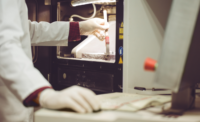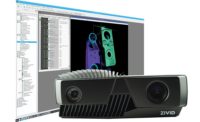CoaXPress (CXP) has developed into a new standard in industrial image processing in recent years. The CXP interface, which is particularly relevant whenever high data rates and short latency periods are called for, is now available in a new version with more improvements.
CoaXPress – The Standard For High Data Rates
Increasing the data throughput rates is one of the key trends for industrial image processing in production automation and optical inspection. While sensor performance has restricted data throughput rates in the past, the bottleneck in data transmission speeds today tends to be created by interfaces such USB 3.0 in the prevalent CMOS sensors with their high frame rates. But thanks to high-speed interfaces such as CoaXPress, users have been able to fully utilize the potential of modern image sensors and achieve maximum performance in their applications.
Characteristics Of CXP 2.0
To continue the success CoaXPress well into the future, constant work has been performed on improving the standard. This work culminated in the standard 2.0, which features four major innovations.
The first innovation lies in expanding the supported bit- rates by two expansion levels (CXP-10 & CXP-12), where CXP now represents one of the fastest interface technologies in industrial image processing with a maximum of 12.5 Gbps per second.
Even with these data rates, a single CoaXPress cable can be used, as the power supply is also provided via this cable. High-resolution sensors with a high frame rate can be used with these high data volumes.
The second innovation is the standardization of one plug type: the Micro-BNC or HD-BNC plug. It combines the advantages of the small design size of the DIN1.0/2.3 with the secure bayonet closure of the BNC plug.
The standardization reduces the complexity of the cable selection and enables simpler processing in the systems.
Ensuring compatibility of the devices with GenTL is the third innovation. It greatly simplifies the integration of various cameras and frame grabbers into the conventional image processing libraries.
The fourth innovation is mostly effective in the background. Greater selection and declining prices in the electronic components required for data transmissions have been evident for some time. New developments can be found in transceivers as well as the FPGAs. By now, these components are offered by multiple manufacturers and have a better price/performance ratio. They ensure improved long-term availability of the various components.
Setup Of A Classic CoaXPress 2.0 Machine Vision System
The illustration shows the typical setup of a CoaXPress 2.0 system. Compared with compact USB3.0 or GigE cameras, the CXP camera tends to be larger.
This is partly due to the larger installed sensors that are operated at very high speeds and higher megapixel, which also means that a larger amount of generated heat must be dissipated. The advantage of the CXP 2.0 standard can be seen on the back of the camera. Unlike the preceding version, this makes it possible to set up a system with a reduced number of data cables. I/O cables can frequently be dispensed with, since the power supply and triggering are provided by the coaxial cable.
The new standardized Micro-BNC connections are more robust and the use of fewer cables makes the system setup much easier and more flexible.
In each case, one frame grabber or one interface card are required for the system. Its function is to reduce the CPU load of the host PC. Customers must ultimately decide whether they want to use a frame grabber or interface card. The differences lie in the price and the technical design. The frame grabber is technologically more sophisticated, because it includes preprocessing and other image processing features, for example.
Advantages Of CoaXPress 2.0
Very High Bandwidth – Maximizing Throughput
At up to 12.5 Gbps, CoaXPress is currently one of the fastest interfaces on the market.
Sufficient Cable Lengths – Bridging Long Distances
Customers frequently have problems with maximum cable lengths under 10 meters, as permitted by a USB 3.1 gen. 1 interface or a Camera Link interface. With up to 40 m and a much higher bandwidth, CoaXPress offers a very good alternative. It is even possible to bridge cable lengths of more than 100 meters with a low bandwidth.
Plug-And-Play – Easy To Connect
CoaXPress enables data transmission as well as power supply via the coaxial cable, making it easy to establish a connection between the camera and PC. The CXP standard is also coupled to the GeniCam standard and corresponds to other conventional vision standards. From a software perspective, that is why this standard offers a simple connection between the PC software and camera.
Exact Synchronization – Precise Control
The optimal combination of frame grabber technology with the cameras used makes it possible to get highly precise camera synchronization even in multi-camera systems with very low latency periods.
Cost Benefits With Easier System Setup And Component Availabilities
Newly available electronics components as well as the option of using single-cable solutions result in a greatly improved price/benefit ratio. CoaXPress 2.0 (CXP-12) is the interface with the lowest costs per transferred megabyte!
CoaXPress systems are particularly suitable for applications that require the synchronized image capture of multiple high-resolution cameras at high speeds. For example, if an object that moves quickly along a conveyor belt must be recorded and evaluated from multiple perspectives for industrial inspection, both the precise triggering of all cameras and synchronization between the devices are extremely important for a correct analysis. Such a scenario can be found in sectors of the semiconductor industry, production automation, medicine, sports and motion analysis.
Checklist: When Is CoaXPress Suitable For Your Application?
If one of the following applies to you, you should take a closer look at CoaXPress technology:
- You want to utilize the full speed of your high-resolution sensor, but the current interface prevents this.
- Your current interface requires very bulky and rigid cables, which makes a space-saving integration harder for you.
- You want to bridge greater distances while maintaining the same high speed.
- You want to use cameras with the latest high-resolution image sensor technology.
- You want to synchronously operate multiple fast, high-resolution cameras precisely via the data cable.
- You want to upgrade from analog or Camera Link cameras.
- You need a system that generates a low CPU load for image acquisition.
Conclusion
For almost ten years, the CoaXPress standard (CXP-1 to CXP-6) has established itself in the market in its first development cycle with a transfer rate of up to 6.25 Gbit/s per channel. The hardware currently available for CXP-1 to -6 is increasingly affordable and becoming more competitive with the proven industry standards such as Camera Link.
The newly developed CoaXPress 2.0 standard will increase the performance of your vision system with twice the data rate. This means that the bandwidth of the cameras can be doubled. CoaXPress thus offers a very attractive, simple and above all reliable perspective for sophisticated high-speed applications now and in the future.
Thomas Karow is a product market manager at Basler AG. For more information, email [email protected] or visit https://www.baslerweb.com/en/sales-support/knowledge-base/visioninterfaces/.






